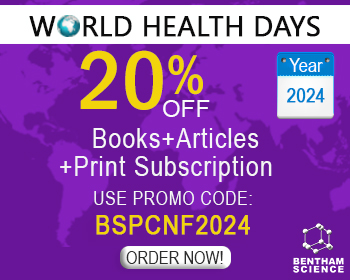Abstract
Tamarixetin and its glycosides are widely distributed in natural plants, and they are also natural flavonoid derivatives of quercetin. Its main pharmacological effects include antioxidant, antiinflammatory, antiviral, anticancer, cardiovascular effects, etc. The pharmacokinetics showed that the distribution of direct absorption differed from that of biosynthesis. At the same time, research shows that tamarixetin is safe to use because it has little self-toxicity. In this paper, 181 articles on tamarixetin published from 1976 to 2023 are obtained from PubMed, China Knowledge Base Database, Wanfang Data, and other electronic databases. Tamarixetin is searched based on keywords, and 121 articles remain. Transformation synthesis, pharmacokinetics, pharmacological action, and structureactivity relationship of tamarixetin were reviewed.
Keywords: Tamarixetin, tamarixetin glycoside, transformation synthesis, pharmacokinetics, pharmacological action, structureactivity relationship.
[http://dx.doi.org/10.3109/10715768709065294] [PMID: 3504810]
[http://dx.doi.org/10.1007/s00606-011-0532-1]
[PMID: 17918432]
[http://dx.doi.org/10.1016/S0031-9422(96)00446-3] [PMID: 8987909]
[http://dx.doi.org/10.1007/s11418-017-1081-x] [PMID: 28251520]
[http://dx.doi.org/10.1021/jf071709t] [PMID: 17867637]
[http://dx.doi.org/10.1016/0031-9422(90)87140-P]
[http://dx.doi.org/10.1016/S0014-5793(97)00467-5] [PMID: 9199494]
[http://dx.doi.org/10.1186/s12934-015-0261-1] [PMID: 26051114]
[http://dx.doi.org/10.1021/acs.jnatprod.8b00155] [PMID: 29851490]
[http://dx.doi.org/10.1038/s41586-020-2180-5] [PMID: 32225176]
[http://dx.doi.org/10.1021/acs.jafc.0c05064] [PMID: 33179911]
[http://dx.doi.org/10.1016/j.cell.2020.02.058] [PMID: 32155444]
[http://dx.doi.org/10.1126/science.abb2762] [PMID: 32132184]
[http://dx.doi.org/10.1088/1757-899X/1192/1/012025]
[http://dx.doi.org/10.1016/j.foodchem.2010.09.065]
[http://dx.doi.org/10.1016/j.ijbiomac.2020.09.232] [PMID: 33010267]
[http://dx.doi.org/10.1080/13880200590903264]
[http://dx.doi.org/10.1079/BJN20051504] [PMID: 16176603]
[http://dx.doi.org/10.1021/jf025922v] [PMID: 12617605]
[http://dx.doi.org/10.1211/0022357044021] [PMID: 15285849]
[http://dx.doi.org/10.1016/j.foodchem.2004.01.041]
[http://dx.doi.org/10.1016/S0378-8741(01)00354-3] [PMID: 11694365]
[http://dx.doi.org/10.1021/jf0715166] [PMID: 17902627]
[http://dx.doi.org/10.1016/S0031-9422(00)90632-0]
[http://dx.doi.org/10.1007/s10616-018-0275-8] [PMID: 30603920]
[http://dx.doi.org/10.1007/s002280000197] [PMID: 11151743]
[http://dx.doi.org/10.1002/biof.5520120127] [PMID: 11216481]
[http://dx.doi.org/10.1016/S0006-2952(01)00758-4] [PMID: 11597584]
[http://dx.doi.org/10.1111/j.1538-7836.2004.01067.x] [PMID: 15613018]
[http://dx.doi.org/10.1016/j.fct.2007.05.015] [PMID: 17698276]
[http://dx.doi.org/10.1371/journal.pone.0009673] [PMID: 20300638]
[http://dx.doi.org/10.1021/acs.jafc.8b03049] [PMID: 30207714]
[http://dx.doi.org/10.1016/j.jnutbio.2007.06.004] [PMID: 17904346]
[http://dx.doi.org/10.1038/sj.bjp.0706662] [PMID: 16444288]
[http://dx.doi.org/10.5897/JMPR11.1108]
[http://dx.doi.org/10.1155/2019/6932053] [PMID: 31885660]
[http://dx.doi.org/10.3168/jds.2012-5439] [PMID: 22916908]
[http://dx.doi.org/10.3168/jds.2012-6234] [PMID: 23403185]
[http://dx.doi.org/10.3168/jds.2015-9361] [PMID: 25795488]
[http://dx.doi.org/10.1016/j.jchromb.2005.12.043] [PMID: 16434241]
[http://dx.doi.org/10.1021/jf303055b] [PMID: 23009399]
[http://dx.doi.org/10.1002/mc.22055] [PMID: 23765509]
[http://dx.doi.org/10.1055/s-0030-1249962] [PMID: 20486074]
[http://dx.doi.org/10.1002/mnfr.201200619] [PMID: 23319447]
[http://dx.doi.org/10.1017/S0007114515000537] [PMID: 25865751]
[http://dx.doi.org/10.1007/s002800050989] [PMID: 10501907]
[http://dx.doi.org/10.1021/jf302068v] [PMID: 22860763]
[http://dx.doi.org/10.3390/ijms15057475] [PMID: 24786288]
[http://dx.doi.org/10.1080/14786419.2022.2027938] [PMID: 35075960]
[http://dx.doi.org/10.15586/aei.v49i3.75] [PMID: 33938187]
[http://dx.doi.org/10.1099/jmm.0.001374] [PMID: 34313585]
[http://dx.doi.org/10.1002/bab.1958] [PMID: 32430989]
[http://dx.doi.org/10.1016/j.ejphar.2020.173808] [PMID: 33345858]
[PMID: 29399199]
[http://dx.doi.org/10.4103/0973-1296.149704] [PMID: 25709211]
[http://dx.doi.org/10.1007/s12010-019-03033-x] [PMID: 31093908]
[http://dx.doi.org/10.1016/S0278-6915(98)00022-2] [PMID: 9734712]
[http://dx.doi.org/10.1016/j.foodchem.2012.12.021] [PMID: 23497885]
[http://dx.doi.org/10.1038/s41598-022-07087-6] [PMID: 35273218]
[http://dx.doi.org/10.3329/bjp.v13i2.36133]
[http://dx.doi.org/10.1111/j.1476-5381.2009.00632.x] [PMID: 20148891]
[http://dx.doi.org/10.1055/s-0039-1694028] [PMID: 31367693]
[http://dx.doi.org/10.1124/jpet.302.1.66] [PMID: 12065701]
[http://dx.doi.org/10.1016/j.abb.2017.11.009] [PMID: 29169900]
[http://dx.doi.org/10.1186/s13020-020-00313-1] [PMID: 32256687]
[http://dx.doi.org/10.1016/j.yjmcc.2016.06.001] [PMID: 27262674]
[http://dx.doi.org/10.1007/s11010-016-2849-0] [PMID: 27766529]
[http://dx.doi.org/10.1152/ajpheart.00633.2016] [PMID: 28011588]
[http://dx.doi.org/10.1007/s10735-019-09831-1] [PMID: 31111288]
[http://dx.doi.org/10.1021/acs.jnatprod.2c00138] [PMID: 35833867]
[http://dx.doi.org/10.1038/s41598-022-18362-x] [PMID: 35978046]
[http://dx.doi.org/10.4236/ojgas.2016.61002]
[http://dx.doi.org/10.1124/jpet.121.001055] [PMID: 36041883]
[http://dx.doi.org/10.1111/j.1600-079X.2007.00443.x] [PMID: 17614836]
[http://dx.doi.org/10.1021/acs.jnatprod.6b00957] [PMID: 28493718]
[http://dx.doi.org/10.1016/j.neulet.2022.136965] [PMID: 36379389]
[http://dx.doi.org/10.1192/bjp.186.2.99] [PMID: 15684231]
[PMID: 18468390]
[PMID: 8114692]
[http://dx.doi.org/10.1124/dmd.112.049791] [PMID: 23378627]
[http://dx.doi.org/10.1111/bph.12284] [PMID: 23809009]
[http://dx.doi.org/10.1016/j.jbbm.2005.08.001] [PMID: 16182371]
[http://dx.doi.org/10.1055/s-0029-1185944] [PMID: 19637114]
[http://dx.doi.org/10.1089/jmf.2021.K.0126] [PMID: 35320012]
[http://dx.doi.org/10.1021/acs.jafc.1c01729] [PMID: 34003649]
[http://dx.doi.org/10.1515/znc-2018-0167] [PMID: 30721147]
[PMID: 12010860]
[http://dx.doi.org/10.1017/S0007114512000104] [PMID: 22453033]



























